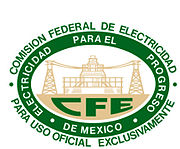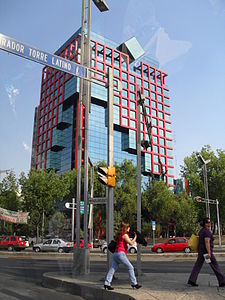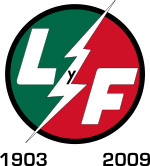- Comisión Federal de Electricidad
-
Comisión Federal de Electricidad Type Government-owned corporation Industry Electricity generation, transmission and distribution Founded 1937 Headquarters Mexico City, Mexico Key people Antonio Vivanco Casamadrid (CEO) Products Electricity Revenue  US$ 20.6 billion
US$ 20.6 billionNet income  US$ -682.5 million
US$ -682.5 millionEmployees 80,127 Website http://www.cfe.gob.mx The Comisión Federal de Electricidad (English: Federal Electricity Commission) is the Mexican state-owned electric widely known as CFE. It is the dominant electric company and the second most powerful state-owned company in Mexico after Pemex. The Mexican constitution states that the government is responsible for the control and development of the national electric industry, and CFE carries out this mission. The company's slogan is "Una empresa de clase mundial" ("A World-Class Company").
CFE is not a part of the North American Electric Reliability Corporation, though its transmission system in northern Baja California is part of the Western Electricity Coordinating Council, and it also has a few other interconnections across the border with local utilities in the United States.
Contents
History
Constitutional reforms
Over the years, plans for a reformed electricity sector, which include private investments on CFE, have been discussed. Most of these plans have been rejected because customers perceive this as an "undercover privatization". Proponents claim that CFE has grown up to become a monopolistic company, used by the federal government to control the electric industry and as a source of income. Critics point out the inefficient service provided by private gas companies (gas service was provided by CFE until 1997), and that customers have to pay high prices (even though they were told that the privatization of this service would decrease costs). Currently, critics claim that private utilities (which sell electric excedents to CFE) could be used as a first step towards a privatization.
Divisions
CFE's coverage area is divided into several divisions:
- Baja California (Baja California peninsula)
- Baja California
- Baja California Sur
- Noroeste (North West)
- Sonora
- Sinaloa
- Norte (North)
- Durango
- Chihuahua
- Golfo Norte (North Gulf)
- Coahuila
- Nuevo Léon
- Tamaulipas
- Bajío (Lowlands)
- Aguascalientes
- Guanajuato
- Hidalgo
- Querétaro
- Zacatecas
- Golfo Centro (Central Gulf)
- Tamaulipas
- San Luis Potosí
- Jalisco
- Jalisco
- Nayarit
- Centro Occidente (West Central)
- Colima
- Michoacán
- Centro Sur (South Central)
- Estado de México
- Mexico City
- Morelos
- Guerrero
- Centro Oriente (East Central)
- Puebla
- Tlaxcala
- Oriente (East)
- Veracruz
- Sureste (South East)
- Chiapas
- Oaxaca
- Tabasco
- Peninsular (Yucatán peninsula)
- Campeche
- Quintana Roo
- Yucatán
Takeover of Luz y Fuerza del Centro
On 12 October 2009, President Felipe Calderón issued a decree dissolving the state-owned company Luz y Fuerza del Centro (LFC, also rendered on logo as "LyF"), which served customers in Mexico City, as well as most of the State of Mexico and some communities in the states of Morelos, Hidalgo and Puebla. LFC was, perhaps, an anachronism within in the Mexican energy sector because it was meant to be dissolved when President Adolfo López Mateos nationalized the private electric companies in September 1960, but the process was never carried out. Pressure from LFC workers, whose value as political force for the PRI regime was considerable, may have played a role in the company's continued existence. From then on, CFE went on to control the national electric system and expand its operations nationwide, while the smaller LFC kept a low profile, maintaining its operations in the central region of Mexico.
LFC provided electricity to several states where, by virtue of a federal law, CFE had no operations (a 1985 agreement between CFE and LFC increased the areas served by the former). The company was often regarded as an inefficient, corrupt company which could not be reformed, and its image was always negative. Some people even coined the term "Luz y A Fuerzas" (roughly translated as "Barely Light and Power"), because the obsolete equipment and networks LFC used, as well as the rampant corruption within the company.
The presidential decree became the center of legal controversies because it was believed that the President was not legally entitled to dissolve a state company. The Mexican constitution, however, grants presidents the power to dissolve such companies, as pointed out by renowned legal experts, without needing to inform or even request permission from the Congress. As of March 2010, LFC's operations have been fully absorbed by CFE, and plans to modernize and expand the old LFC network have been drafted, waiting for approval. CFE employees replaced LFC's staff, which sparked protests from SME members (SME was the labor union grouping LFC employees), who demand to be hired by CFE (CFE workers are members of SUTERM, SME's rival).
Another source of tensions is the frequent protests and aggressions against CFE employees by SME members. Acts of sabotage have occurred since LFC's incorporation into CFE, but SME has denied any involvement. SME claims that CFE staff is unexperienced and poorly organized, and that damages in LFC systems cannot be repaired by CFE. However, these allegations are baseless, since CFE has the control of high-scale projects across the country (operating high voltage lines, power plants, substations, etc.), whereas LFC does not.
Miscellaneous
Since the CFE is the dominant electric company in Mexico, most customers refer to it as "la comisión" (e.g. "The commission"). While there are other Mexican government commissions, the term is almost exclusively applied to the CFE.
See also
- Electricity sector in Mexico
- Ernesto Piedras, occupied several positions in the Commission
External links
- CFE official site
- Servicio de Administración y Enajenación de Bienes (SAE) "Organismo Descentralizado Luz y Fuerza del Centro" (LFC)
- Mexico: The Murder of a Union and the Rebirth of Class Struggle by Richard Roman and Edur Velasco Arregui, The Bullet #279, November 25, 2009.
References
Categories:- Government-owned companies in Mexico
- Energy in Mexico
- Baja California (Baja California peninsula)
Wikimedia Foundation. 2010.





